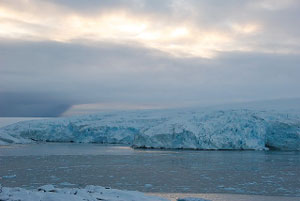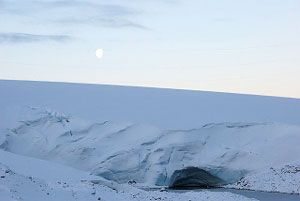

 | |||||||||||
|
|
Journals 2008/2009Megan O'Neill
June 2, 2009 Woke up to a beautiful night sky with stars shining brightly all around as I walked to the Bio building for breakfast and coffee. Because there was not cloud cover in the sky, the temperature was noticeably lower. The temperature was about -3.5°C. It was going to be a beautiful day! After lunch, Sean invited me up to the helipad to "throw around some barrels." Mind you, these were not just any old barrels! These are hazardous waste drums that have to be moved to get loaded onto the ship. Figuring out the logistics of the waste produced here is tough to get your mind wrapped around and it is the task of the Waste Management Team or the "Wasties" as they term themselves all headed by Mark Furnish, the U.S. Antarctic Program Waste Management Director. Not only is the hazardous waste an issue, but just the general waste produced. As you can imagine, decomposition without bacteria and warm temperatures is not an option and incineration is also not compliant with the Antarctic Treaty. Therefore all of the waste produced at the station is put into 55-gallon steel drums and then into metal containers called milvans (short for military vans) or simply into the milvans if it is solid waste and shipped back to the U.S., if it is hazardous and to Chile if it is not. All of this sorting, documenting, tracking and transportation are a huge, expensive process. As I attempted to move one of the barrels and failed miserably because of the incredible weight of the barrel, I quickly realized why Kris jokes about Sean using many choice words when moving these monstrosities. With the liquid materials, these drums can weigh up to 600 pounds each. This leads to another factor in the transportation equation, which is the weight limit for the crane that loads the containers onto the ship. Therefore, they cannot stack the barrels in the milvans because the weight limit would be exceeded. So many different considerations (Mark's headaches to prove it)! Just as I always tell my students when studying solid waste issues in Environmental Science, "You don't actually throw something 'away' because where exactly is 'away'?!" All of our waste goes somewhere, no matter where on the planet you may be - the Earth is definitely a closed system in regards to our waste. Before the sunset at 2:30 p.m. (not that we actually see the sun anymore because it is so low on the horizon), I was able to hike into the "backyard" of Palmer Station and take some wonderful photos of the beautiful day. A few fur seals by the water, the glacier, a storm in the distance, the pink colors on the water against the blue icebergs, snow covered rocks all made for delightful subjects. In the lab, we are dissecting some of the species of fish known as L. kempi that Jody and Bruce put through CT Max experiments. Jody is collecting hematocrit levels from them to compare with the other fish and Lisa and Jeff are collecting hearts from them for their lipid experiments. Starting to wrap up the dissections - tomorrow is the next to last day for science work!
|
||||||||||

